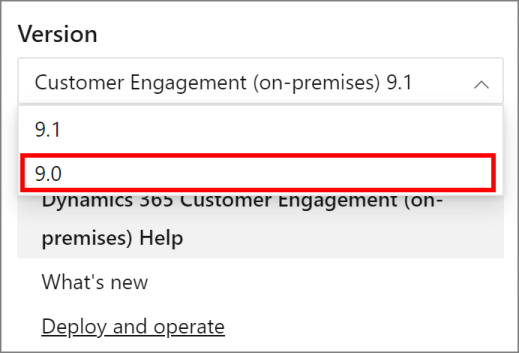Sample server XML configuration file
This article doesn't apply to the Dynamics 365 Customer Engagement (on-premises), version 9.1 update. For information about new features in update 9.1, see What's new.
For information about this topic for Dynamics 365 Customer Engagement (on-premises), version 9.0, select the version located above the left navigation pane.

The following configuration file installs an update file that is located on an internal share, installs a Full Server with all Dynamics 365 Server features, and creates new databases on the default instance of a SQL Server that is named SQLServer.
<CRMSetup>
<Server>
<Patch update="true">\\ServerName\ShareName\patchfile.msp</Patch>
<LicenseKey>XXXXX-XXXXX-XXXXX-XXXXX-XXXXX</LicenseKey>
<SqlServer>SQLServer</SqlServer>
<Database create="true"/>
<Reporting URL="https://MyReportingServer/ReportServer"/>
<OrganizationCollation>Latin1_General_CI_AI</OrganizationCollation>
<basecurrency isocurrencycode="USD" currencyname="US Dollar" currencysymbol="$" currencyprecision="2"/>
<Organization>Organization Display Name</Organization>
<OrganizationUniqueName>Organization-Name</OrganizationUniqueName>
<OU>OU=value,DC=subdomain,DC=subdomain,DC=subdomain,DC=com</OU>
<WebsiteUrl create="true" port="5555"> </WebsiteUrl>
<InstallDir>c:\Program Files\Microsoft Dynamics CRM</InstallDir>
<CrmServiceAccount type="DomainUser">
<ServiceAccountLogin>Contoso\CRMAppService</ServiceAccountLogin>
<ServiceAccountPassword>password</ServiceAccountPassword>
</CrmServiceAccount>
<SandboxServiceAccount type="DomainUser">
<ServiceAccountLogin>Contoso\CRMSandboxService</ServiceAccountLogin>
<ServiceAccountPassword>password</ServiceAccountPassword>
</SandboxServiceAccount>
<DeploymentServiceAccount type="DomainUser">
<ServiceAccountLogin>Contoso\CRMDeploymentService</ServiceAccountLogin>
<ServiceAccountPassword>password</ServiceAccountPassword>
</DeploymentServiceAccount>
<AsyncServiceAccount type="DomainUser">
<ServiceAccountLogin>Contoso\CRMAsyncService</ServiceAccountLogin>
<ServiceAccountPassword>password</ServiceAccountPassword>
</AsyncServiceAccount>
<VSSWriterServiceAccount type="DomainUser">
<ServiceAccountLogin>Contoso\CRMVSSWriterService</ServiceAccountLogin>
<ServiceAccountPassword>password</ServiceAccountPassword>
</VSSWriterServiceAccount>
<MonitoringServiceAccount type="DomainUser">
<ServiceAccountLogin>Contoso\CRMMonitoringService</ServiceAccountLogin>
<ServiceAccountPassword>password</ServiceAccountPassword>
</MonitoringServiceAccount>
<SQM optin="true"/>
<muoptin optin="true"/>
<!-- Settings for IFD installation. May be skipped for intranet-only deployment or to configure IFD later. -->
<ifdsettings enabled="false">
<!-- Define what address considered internal, required only if enabled=true -->
<internalnetworkaddress>10.0.0.1-255.0.0.0</internalnetworkaddress>
<!-- Define URLs with IFD authentication, required only if enabled=true -->
<rootdomainscheme>http</rootdomainscheme>
<sdkrootdomain>api.contoso.com</sdkrootdomain>
<webapplicationrootdomain>app.contoso.com</webapplicationrootdomain>
<discoveryrootdomain>disc.contoso.com</discoveryrootdomain>
</ifdsettings>
<Email>
<IncomingExchangeServer name="ExchangeServerName"/>
</Email>
</Server>
</CRMSetup>
Caution
Maintaining the configuration file that has ServiceAccountLogin and ServiceAccountPassword values specified is a security risk because you are storing a password in plain text. Delete these elements as soon as the configuration file is used to install Dynamics 365 Server.
See Also
Microsoft Dynamics 365 Server XML configuration file
Sample server XML configuration file for installing with pre-created groups
Feedback
Coming soon: Throughout 2024 we will be phasing out GitHub Issues as the feedback mechanism for content and replacing it with a new feedback system. For more information see: https://aka.ms/ContentUserFeedback.
Submit and view feedback for